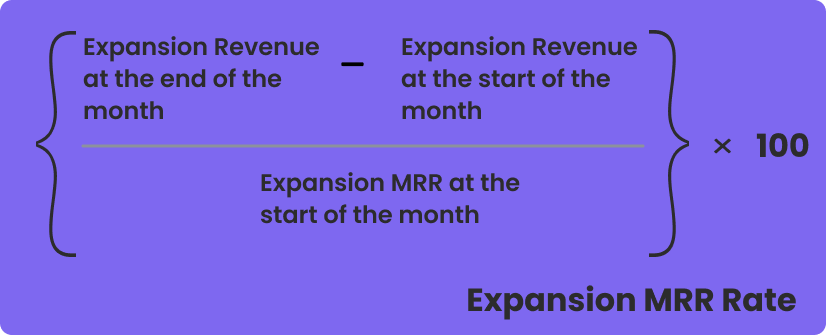Expansion Revenue: Definitions, Metrics, Formulas and Tips

Recurring revenue is essential for any SaaS business. You are probably aware of the fact that customer acquisition is often very expensive, with the risk of getting only a few lukewarm leads. Now, is it possible to cut customer acquisition costs and still generate more recurring revenue? This is precisely what expansion revenue brings to the table.
So, what is expansion revenue? Expansion revenue is all the additional revenue you get from existing customers. Greater expansion revenue means that your customers are happy, and a happy customer will stick with you longer, which means improved customer retention rates and increased revenue for your company.
If you wish to learn more about expansion revenue, rates, metrics, but also effective ways to increase it, keep reading.
What Is Expansion Revenue?
Expansion revenue, or expansion MRR (monthly recurring revenue), refers to the additional revenue you get from existing customers via upgrades, new features, and their increased usage.
This type of revenue is extremely important for SaaS companies, as it improves customer success, customer lifetime value and overall business health. Also, by tracking this metric regularly, you can better recognize opportunities for upselling within your customer base and drive overall revenue growth.
Also, let’s not mix two terms: upsell vs expansion. They differ in a few crucial ways. Upselling includes implementing effective ways to persuade existing customers to subscribe to higher-tier plans or additional services, while expansion is not only limited to upselling but also includes strategies for cross-selling additional services, features or modulus to existing subscriptions. Still, they are both vital for improving customer lifetime value and revenue growth in SaaS.
What is a Good Expansion Revenue Rate (Expansion MRR Rate)?
Although higher rates are always the best option, a rate between 10 and 30% is considered to be a good one for SaaS companies. Good expansion revenue proves that your customers are satisfied with the product and are willing to spend more as they find it valuable. By helping their businesses grow, you are directly helping your own flourish as well. This is precisely how you nurture long-term customer relationships.
Still, don’t try too hard to improve the expansion rates by forcing premium plans and additional services too much, all the time. By being too pushy, you can repel certain customers and do more damage than good. A rate of 20-30% is more than enough for your business not to depend solely on new revenue from new customers.
Expansion Revenue Metrics You Should Know
Growth and expansion go hand in hand in SaaS, and that’s why it is vital to know which metrics to track to assess the strategies you implement for revenue growth. Here are the crucial SaaS metrics related to expansion revenue:
- Expansion MRR
- Expansion MRR shows the additional revenue you generated from existing customers who upgraded their plans or purchased new features.
- Expansion rate
- The expansion rate shows the percentage of existing customers who spent more compared to the previous period.
- Net Expansion Rate
- Net Expansion Rate measures the change in MRR from existing customers. It includes expansion revenue, churned revenue, and contraction revenue, which is the revenue you lose from downgrades. If the Net Expansion Rate is higher than 100%, it means that it beats the churned and contraction revenue, which leads to new revenue growth from existing customers.
- Customer Lifetime Value (CLTV)
- CLTV shows the expected revenue from a customer throughout their entire customer journey. Expansion revenue can increase CLTV by contributing to the increase in revenue you get from each customer.
How to Calculate Expansion Revenue?
The first thing you need to do to calculate expansion revenue is to identify customers who have upgraded their plans, purchased additional features, or increased their usage compared to the previous period. With the customer success platform Akita and its advanced customer segmentation options, you can do that easily. Akita allows you to segment customers based on any trait you find important. Besides numbers and traits, you can add several columns to a segment, like health scores and trends, and get a full overview of each customer within seconds.
The second step would be calculating additional revenue for each customer so that you can, finally, sum up the expansion revenue generated from all customers and get a result that reflects the expansion revenue for the given period.
Here’s the formula to assess SaaS revenue expansion: Expansion Revenue (Expansion MRR)= Sum of additional revenue from all customers

By tracking expansion revenue regularly, you can better evaluate the efficiency of your current expansion strategies and optimize them as you go.
And lastly, here is the formula to calculate the expansion MRR rate.

How to Increase Expansion Revenue?
Growing expansion revenue is the goal for all SaaS companies, as it clearly shows whether the value you provide to your customers is satisfactory or not. Now, let’s see some common effective strategies that can help you improve revenue expansion over time:
1. Perform Customer Segmentation
By identifying and pinpointing customers who can benefit from upselling campaigns, you are increasing the conversion rates. Use Akita to segment customers based on their behavior, purchasing trends, usage patterns, and other traits to be able to create and launch targeted and personalized upselling campaigns.
2. Invest in Customer Success
When you align customer needs with your offerings, you can effectively reduce churn and increase customer retention and loyalty. Monitor customer health scores regularly and encourage customer engagement to improve chances for expansion.
3. Offer Discounts and Promotions
Motivate customers to upgrade or purchase new features by offering things they can’t decline.
4. Educate Customers
By providing customers with educational resources like tutorials and webinars, you can help them better understand the full potential and value of your product. If they manage to realize quickly that they can benefit from your product in certain ways, there is a greater chance of expansion.
5. Collect Feedback
Feedback is one of the most essential resources you get from your customers, where they share their experiences, needs and challenges. Use the given feedback to make certain improvements and identify expansion opportunities.
6. Monitor Expansion Revenue Metrics
Make sure to monitor and assess the metrics regularly so that you can adjust your expansion strategies when needed and increase expansion and growth.
Importance of Expansion Revenue for SaaS Companies
SaaS companies rely heavily on expansion revenue for survival, as it directly affects customer lifetime value, long-term growth and profitability. When you get extra revenue from existing customers, it means that your business is healthy and your product is valuable and wanted.
The main goal of any SaaS business is to improve retention rates and decrease churn, and this is precisely where expansion revenue helps by ensuring steady revenue streams from loyal customers without the need for additional investments in customer acquisition.
If the revenue expansion rate is good, it indicates that your customer success and sales teams are on the same page, which means that you promote an excellent customer experience, which further motivates expansions and renewals.
Conclusion
So, what is expansion revenue and why is it important for SaaS? Expansion revenue is one of the most important revenue growth components in SaaS, as it represents the additional revenue you get from existing customers who upgraded their plans and purchased additional services.
Expansion revenue directly contributes to revenue growth, customer lifetime value, customer retention, and business scalability, which makes it a key segment that drives business growth and creates long-term customer relationships.
Sounds great, right? Monitor your expansion revenue metrics with Akita and never miss the opportunity to upsell, prevent churn and improve customer retention.
Frequently Asked Questions
What does "expand revenue" mean?
“Expand revenue” refers to increasing revenue streams. This can include various expansion strategies where you get additional revenue from existing customers, which leads to increased customer satisfaction, retention, and customer lifetime value.
What is net expansion revenue?
Net expansion revenue is a metric that shows the change in revenue from existing customers over a certain period of time.
What are expansion sales?
Expansion sales refer to the act of selling additional features, products, or services to existing customers. In SaaS, expansion sales often involve upselling or cross-selling to customers who already use the product or service.








